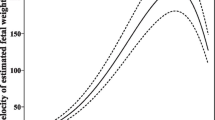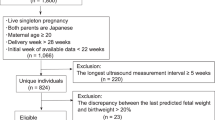Abstract
Purpose of Review
In this narrative review, we outline recent evidence relating longitudinal ultrasound (US) measurements to offspring outcomes in the perinatal period and in childhood, with an emphasis on the methodological approaches for describing fetal growth.
Recent Findings
The utility of longitudinal ultrasonography (US) to measure fetal growth and determine fetal trajectories is valued in both clinical and research environments. Evidence shows that repeated measures of US throughout pregnancy are useful for distinguishing between a growth-restricted and constitutionally small fetus, the former burdened by adverse clinical outcomes. Fetal growth restriction and small for gestational age are not interchangeable terms, although both can exist in the same individual.
Summary
The application of longitudinal US may have predictive value when determining longer-term health and disease outcomes in offspring born growth-restricted. However, it is important to remember that associations between fetal growth restriction and increased risk for non-communicable diseases are likely modified by postnatal growth.
Similar content being viewed by others
References
Wollmann HA. Intrauterine growth restriction: definition and etiology. Horm Res. 1998;49(Suppl 2):1–6.
Unterscheider J, et al. Fetal growth restriction and the risk of perinatal mortality—case studies from the multicentre PORTO study. BMC Pregnancy Childbirth. 2014;14:63.
Sharma, K.J., et al. Pregnancies complicated by both preeclampsia and growth restriction between 34 and 37 weeks’ gestation are associated with adverse perinatal outcomes. J Matern Fetal Neonatal Med, 2016;1–4.
Sonnenschein-Van Der Voort AM, et al. Foetal and infant growth patterns, airway resistance and school-age asthma. Respirology. 2016;21(4):674–82.
Ostgard HF, et al. Neuropsychological deficits in young adults born small-for-gestational age (SGA) at term. J Int Neuropsychol Soc. 2014;20(3):313–23.
Alkandari F, et al. Fetal ultrasound measurements and associations with postnatal outcomes in infancy and childhood: a systematic review of an emerging literature. J Epidemiol Community Health. 2015;69(1):41–8.
Paneth N. Invited commentary: the hidden population in perinatal epidemiology. Am J Epidemiol. 2008;167(7):793–6. author reply 797-8
Ott WJ. Intrauterine growth retardation and preterm delivery. Am J Obstet Gynecol. 1993;168(6 Pt 1):1710–5. discussion 1715-7
Zeitlin J, et al. The relationship between intrauterine growth restriction and preterm delivery: an empirical approach using data from a European case-control study. BJOG. 2000;107(6):750–8.
Morken NH, Kallen K, Jacobsson B. Fetal growth and onset of delivery: a nationwide population-based study of preterm infants. Am J Obstet Gynecol. 2006;195(1):154–61.
Hediger ML, et al. Fetal growth and the etiology of preterm delivery. Obstet Gynecol. 1995;85(2):175–82.
Hutcheon JA, Platt RW. The missing data problem in birth weight percentiles and thresholds for “small-for-gestational-age”. Am J Epidemiol. 2008;167(7):786–92.
Kiserud T, et al. The World Health Organization fetal growth charts: a multinational longitudinal study of ultrasound biometric measurements and estimated fetal weight. PLoS Med. 2017;14(1):e1002220.
Papageorghiou AT, et al. International standards for fetal growth based on serial ultrasound measurements: the fetal growth longitudinal study of the INTERGROWTH-21st Project. Lancet. 2014;384(9946):869–79.
Buck Louis GM, et al. Racial/ethnic standards for fetal growth: the NICHD fetal growth studies. Am J Obstet Gynecol. 2015;213(4):449 e1–449 e41.
Hooper PM, Mayes DC, Demianczuk NN. A model for foetal growth and diagnosis of intrauterine growth restriction. Stat Med. 2002;21(1):95–112.
Velez MP, et al. Female digit length ratio (2D:4D) and time-to-pregnancy. Hum Reprod. 2016;31(9):2128–34.
Altman DG, et al. Statistical considerations for the development of prescriptive fetal and newborn growth standards in the INTERGROWTH-21st Project. BJOG. 2013;120(Suppl 2):71–6, v
O'Connor C, et al. Fetal subcutaneous tissue measurements in pregnancy as a predictor of neonatal total body composition. Prenat Diagn. 2014;34(10):952–5.
Gardosi J, et al. Customised antenatal growth charts. Lancet. 1992;339(8788):283–7.
Hutcheon JA, et al. Customised birthweight percentiles: does adjusting for maternal characteristics matter? BJOG. 2008;115(11):1397–404.
Iliodromiti S, et al. Customised and noncustomised birth weight centiles and prediction of stillbirth and infant mortality and morbidity: a cohort study of 979,912 term singleton pregnancies in Scotland. PLoS Med. 2017;14(1):e1002228.
Hinkle SN, et al. Comparison of methods for identifying small-for-gestational-age infants at risk of perinatal mortality among obese mothers: a hospital-based cohort study. BJOG. 2016;123(12):1983–8.
Mikolajczyk RT, et al. A global reference for fetal-weight and birthweight percentiles. Lancet. 2011;377(9780):1855–61.
Toemen L, et al. Longitudinal growth during fetal life and infancy and cardiovascular outcomes at school-age. J Hypertens. 2016;34(7):1396–406.
Gishti O, et al. Fetal and infant growth patterns associated with total and abdominal fat distribution in school-age children. J Clin Endocrinol Metab. 2014;99(7):2557–66.
Gaillard R, Jaddoe VWV. Assessment of fetal growth by customized growth charts. Ann Nutr Metab. 2014;65:149–55.
Dudley NJ. A systematic review of the ultrasound estimation of fetal weight. Ultrasound Obstet Gynecol. 2005;25(1):80–9.
Owen P, et al. Using unconditional and conditional standard deviation scores of fetal abdominal area measurements in the prediction of intrauterine growth restriction. Ultrasound Obstet Gynecol. 2000;16(5):439–44.
Royston P. Calculation of unconditional and conditional reference intervals for foetal size and growth from longitudinal measurements. Stat Med. 1995;14(13):1417–36.
Heppe DHM, et al. Fetal and childhood growth patterns associated with bone mass in school-age children: the generation R study. J Bone Miner Res. 2014;29(12):2584–93.
Keijzer-Veen MG, et al. A regression model with unexplained residuals was preferred in the analysis of the fetal origins of adult diseases hypothesis. J Clin Epidemiol. 2005;58(12):1320–4.
Slaughter JC, Herring AH, Thorp JM. A Bayesian latent variable mixture model for longitudinal fetal growth. Biometrics. 2009;65(4):1233–42.
Barker ED, et al. The role of growth trajectories in classifying fetal growth restriction. Obstet Gynecol. 2013;122(2):248–54.
Bardien, N., et al., Placental insufficiency in fetuses that slow in growth but are born appropriate for gestational age: a prospective longitudinal study. PLoS One [Electronic Resource], 2016. 11(1): p. e0142788.
O'Connor H, et al. Comparison of asymmetric versus symmetric IUGR e results from a national prospective trial. Am J Obstet Gynecol. 2015;1:S173–4.
Gaillard R, et al. Tracking of fetal growth characteristics during different trimesters and the risks of adverse birth outcomes. Int J Epidemiol. 2014;43(4):1140–53.
Sovio U, et al. Screening for fetal growth restriction with universal third trimester ultrasonography in nulliparous women in the pregnancy outcome prediction (POP) study: a prospective cohort study. Lancet. 2015;386(10008):2089–97.
McMaster-Fay RA. Re: Customised birthweight centiles predict SGA pregnancies with perinatal morbidity. BJOG. 2006;113(2):246–7. author reply 247-8
Owen P, Harrold AJ, Farrell T. Fetal size and growth velocity in the prediction of intrapartum caesarean section for fetal distress. Br J Obstet Gynaecol. 1997;104(4):445–9.
Gyamfi-Bannerman C, et al. Nonspontaneous late preterm birth: etiology and outcomes. Am J Obstet Gynecol. 2011;205(5):456 e1–6.
Smith GC, et al. First-trimester growth and the risk of low birth weight. N Engl J Med. 1998;339(25):1817–22.
Mook-Kanamori DO, et al. Risk factors and outcomes associated with first-trimester fetal growth restriction. JAMA. 2010;303(6):527–34.
Goldenberg RL, et al. Epidemiology and causes of preterm birth. Lancet. 2008;371(9606):75–84.
Zhang J, et al. Defining normal and abnormal fetal growth: promises and challenges. Am J Obstet Gynecol. 2010;202(6):522–8.
Turner S. Antenatal origins of reduced lung function-but not asthma? Respirology. 2016;21(4):574–5.
Almakoshi A, et al. Fetal growth trajectory and risk for eczema in a Saudi population. Pediatr Allergy Immunol. 2015;26(8):811–6.
Rogne T, et al. Fetal growth, cognitive function, and brain volumes in childhood and adolescence. Obstet Gynecol. 2015;125(3):673–82.
Lohaugen GC, et al. Small for gestational age and intrauterine growth restriction decreases cognitive function in young adults. J Pediatr. 2013;163(2):447–53.
Kooijman MN, et al. Third trimester fetal hemodynamics and cardiovascular outcomes in childhood: the Generation R study. J Hypertens. 2014;32(6):1275–82.
Soothill PW, Bobrow CS, Holmes R. Small for gestational age is not a diagnosis. Ultrasound Obstet Gynecol. 1999;13(4):225–8.
Altman DG, Hytten FE. Intrauterine growth retardation: let’s be clear about it. Br J Obstet Gynaecol. 1989;96(10):1127–32.
Abraham M, et al. A systematic review of maternal smoking during pregnancy and fetal measurements with meta-analysis. PLoS One. 2017;12(2):e0170946.
Author information
Authors and Affiliations
Corresponding author
Ethics declarations
Conflict of Interest
The authors declare that they have no conflict of interest.
Human and Animal Rights and Informed Consent
This article does not contain any studies with human or animal subjects performed by any of the authors.
Additional information
This article is part of the Topical Collection on Reproductive and Perinatal Epidemiology
Appendix 1. MEDLINE through Ovid (1946–2016 October 17)
Appendix 1. MEDLINE through Ovid (1946–2016 October 17)
MEDLINE through Ovid (1946–2016 October 17).
Resource selected: Epub Ahead of Print, In-Process & Other Non-Indexed Citations, Ovid MEDLINE(R) Daily and Ovid MEDLINE(R) 1946 to Present October 17th 2016
Epub Ahead of Print, In-Process & Other Non-Indexed Citations, Ovid MEDLINE(R) Daily and Ovid MEDLINE(R) 1946 to Present October 17th 2016
Search History
Searches | Results | Type | |
|---|---|---|---|
1 | Fetal development/ or “Embryonic and fetal development”/ or Fetal growth retardation/ or ((Fetus/ or Fetus weight/) and (Growth/ or Gestational age/)) | 50,896 | Advanced |
2 | (anthropometr* or ultrasound or ultrasonograph* or echograph* or sonograph*).mp. or ((conception or fetal or fetus* or foetal or foetus* or in utero or antenatal* or prenatal* or intrauterine) adj15 (measure* or assess* or growth pattern* or growth trajector*)).ti,ab. | 440,831 | Advanced |
3 | Child/ or Child, Preschool/ or Child development/ or exp Child development disorders/ or Child Health/ or Pregnancy Outcome/ or Long term adverse effects/ or Infant/ or “Infant, newborn”/ or “Infant, small for gestational age”/ or exp. “Infant, Low birth weight”/ or Child*.ti,ab. or “Prenatal exposure, delayed effects”/ | 2,567,632 | Advanced |
4 | 1 and 2 and 3 | 4398 | Advanced |
5 | 4 and (Humans/ not Animals/) | 4165 | Advanced |
6 | limit 5 to yr. = “2014 -Current” | 433 | Advanced |
7 | 6 not review.pt. | 387 | Advanced |
Embase through Ovid (1974 to 2016 October 14)
Resource selected  Embase 1974 to 2016 October 14
Embase 1974 to 2016 October 14
Search History
Searches | Results | Type | |
|---|---|---|---|
1 | Fetus growth/ or Intrauterine growth retardation/ or Fetus development/ or Prenatal growth/ or ((“Fetus”/ or Fetus weight/) and (Growth rate/ or Growth retardation/ or Gestational age/)) | 74,954 | Advanced |
2 | (anthropometr* or ultrasound or ultrasonograph* or echograph* or sonograph*).mp. or ((conception or fetal or fetus* or foetal or foetus* or in utero or antenatal* or prenatal* or intrauterine) adj15 (measure* or assess* or growth pattern* or growth trajector*)).ti,ab. | 739,868 | Advanced |
3 | Child/ or Childhood/ or Child development/ or Preschool child/ or Toddler/ or School child/ or Child health/ or Child growth/ or Early childhood/ or child*.ti,ab. or Pregnancy outcome/ or exp Childhood disease/ or Infant/ or Newborn/ or Infancy/ or Postnatal growth/ or Postnatal development/ or “Small for date infant”/ | 2,821,960 | Advanced |
4 | 1 and 2 and 3 | 8882 | Advanced |
5 | 4 and ((Human/ or Normal human/) not (Animal/ or Animal experiment/ or Animal model/ or Nonhuman/)) | 7813 | Advanced |
6 | limit 5 to yr. = “2014 -Current” | 2162 | Advanced |
7 | 6 not review.pt. | 2040 | Advanced |
Rights and permissions
About this article
Cite this article
Larose, T.L., Turner, S.W., Hutcheon, J.A. et al. Longitudinal Ultrasound Measures of Fetal Growth and Offspring Outcomes. Curr Epidemiol Rep 4, 98–105 (2017). https://doi.org/10.1007/s40471-017-0103-2
Published:
Issue Date:
DOI: https://doi.org/10.1007/s40471-017-0103-2




